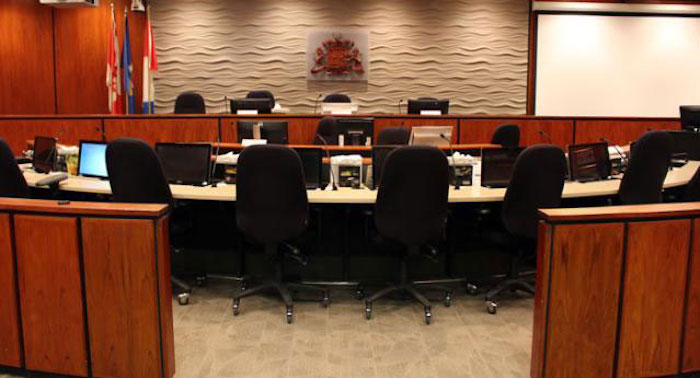Alberta
Red Deer Mayor Veer appointed Honorary Lieutenant-Colonel of 41 Signal Regiment

November 30, 2020
Mayor Veer appointed Honorary Lieutenant-Colonel with the Canadian Armed Forces
(Red Deer, Alberta) – Nominated by the Commanding Officer of 41 Signal Regiment, and signed off by the Minister of National Defence; The City of Red Deer congratulates Mayor Tara Veer on her recent appointment to Honorary Lieutenant-Colonel by the Canadian Armed Forces in recognition of her work in the community, commitment to honouring military veterans, and local reservists.
“I am extremely honoured to have been given the distinguished appointment of Honorary Lieutenant-Colonel with the Canadian Military,” said Mayor Veer. “I am eager to serve in this position, in conjunction with my public duties. The sacrifices of our Canadian Armed Forces and the many veterans that served our country are what have allowed me to serve our community as Mayor. Past and present heroes in the Canadian Armed Forces have made our country what it is today. They are the reason for the freedoms Canadians enjoy today.”
“Mayor Veer has been a dedicated supporter of local troops and I know she will bring the to same dedication to our Squadrons in Edmonton and Calgary as well. I am delighted with her appointment as Honorary Lieutenant-Colonel of 41 Signal Regiment and am excited about the enthusiasm and profile that she brings to this important role in the Canadian Army Reserve.”
Honorary Colonel Lloyd Lewis, 41 Signal Regiment
“Mayor Veer’s remarkable career and contributions to Red Deer will certainly be an inspiration to all of our soldiers with her demonstrated ‘service before self’, leadership, and boundless energy. The soldiers of 41 Signal Regiment are truly honoured to welcome Honorary Lieutenant-Colonel Veer to our ranks.”
Lieutenant-Colonel Steven Flavel, Commanding Officer, 41 Signal Regiment
Honoraries are a tradition going back more than a century in the Canadian Armed Forces. They are typically prominent private citizens who volunteer to act as advocates for their regiments, communities and guardians of regimental traditions and histories. The first Honorary Colonel appointment in Canada was that of Lieutenant-Colonel the Honorable J.M. Gibson, a Provincial Secretary in the Ontario Government. He was appointed as Honorary Lieutenant-Colonel to the 13th Battalion of Infantry in 1895.
Early in the 20th century in Canada, Sir Robert Borden described the practice of appointing Honoraries as “of greatest advantage to the Militia to be able to enlist the interest and sympathy of gentleman of position and wealth by connecting them to Regiments.”
That sentiment remains true today. The Honorary is seen to be the guardian of regimental traditions and history, promoting the regiment’s identity and ethos and being an advisor to the Commanding Officer on virtually all issues excluding operations.
“As an Honorary Lieutenant-Colonel, I will endeavor to foster ‘esprit de corps’ and support the 41 Signal Regiment and its leadership, and work to develop and strengthen the ties between our local military and communities, businesses, and industry throughout Alberta,” said Mayor Veer. “I will fulfill the responsibilities entrusted to me, which include providing a link between the local and provincial Squadrons and the community, and raise the public profile of the Regiment with utmost pride. Thank you to the Canadian Armed Forces for this honour.”
This honorary position builds upon and aligns with Mayor Veer’s role in the community as ambassador and advocate for the needs of the region.
“This is also a recognition for our community, and I share this with the people of Red Deer as I continue to advocate for the betterment of Red Deer for our citizens,” Mayor Veer continued.
The appointment is effective immediately, and is a three year term. A formal installation ceremony will be planned soon pending provincial health protocols.
41 Signal Regiment has squadrons in Red Deer, Edmonton and Calgary.
Click to learn more about the appointment process.
Click for more information about 41 Signal Regiment.
Six stories from local soldiers who have deployed internationally in the past year
Alberta
Early Success: 33 Nurse Practitioners already working independently across Alberta

Nurse practitioners expand primary care access |
The Alberta government’s Nurse Practitioner Primary Care program is showing early signs of success, with 33 nurse practitioners already practising independently in communities across the province.
Alberta’s government is committed to strengthening Alberta’s primary health care system, recognizing that innovative approaches are essential to improving access. To further this commitment, the Nurse Practitioner Primary Care Program was launched in April, allowing nurse practitioners to practise comprehensive patient care autonomously, either by operating their own practices or working independently within existing primary care settings.
Since being announced, the program has garnered a promising response. A total of 67 applications have been submitted, with 56 approved. Of those, 33 nurse practitioners are now practising autonomously in communities throughout Alberta, including in rural locations such as Beaverlodge, Coaldale, Cold Lake, Consort, Morley, Picture Butte, Three Hills, Two Hills, Vegreville and Vermilion.
“I am thrilled about the interest in this program, as nurse practitioners are a key part of the solution to provide Albertans with greater access to the primary health care services they need.”
To participate in the program, nurse practitioners are required to commit to providing a set number of hours of medically necessary primary care services, maintain a panel size of at least 900 patients, offer after-hours access on weekends, evenings or holidays, and accept walk-in appointments until a panel size reaches 900 patients.
With 33 nurse practitioners practising independently, about 30,000 more Albertans will have access to the primary health care they need. Once the remaining 23 approved applicants begin practising, primary health care access will expand to almost 21,000 more Albertans.
“Enabling nurse practitioners to practise independently is great news for rural Alberta. This is one more way our government is ensuring communities will have access to the care they need, closer to home.”
“Nurse practitioners are highly skilled health care professionals and an invaluable part of our health care system. The Nurse Practitioner Primary Care Program is the right step to ensuring all Albertans can receive care where and when they need it.”
“The NPAA wishes to thank the Alberta government for recognizing the vital role NPs play in the health care system. Nurse practitioners have long advocated to operate their own practices and are ready to meet the growing health care needs of Albertans. This initiative will ensure that more people receive the timely and comprehensive care they deserve.”
The Nurse Practitioner Primary Care program not only expands access to primary care services across the province but also enables nurse practitioners to practise to their full scope, providing another vital access point for Albertans to receive timely, high-quality care when and where they need it most.
Quick facts
- Through the Nurse Practitioner Primary Care Program, nurse practitioners receive about 80 per cent of the compensation that fee-for-service family physicians earn for providing comprehensive primary care.
- Compensation for nurse practitioners is determined based on panel size (the number of patients under their care) and the number of patient care hours provided.
- Nurse practitioners have completed graduate studies and are regulated by the College of Registered Nurses of Alberta.
- For the second consecutive year, a record number of registrants renewed their permits with the College of Registered Nurses of Alberta (CRNA) to continue practising nursing in Alberta.
- There were more than 44,798 registrants and a 15 per cent increase in nurse practitioners.
- Data from the Nurse Practitioner Primary Care Program show:
- Nine applicants plan to work on First Nations reserves or Metis Settlements.
- Parts of the province where nurse practitioners are practising: Calgary (12), Edmonton (five), central (six), north (three) and south (seven).
- Participating nurse practitioners who practise in eligible communities for the Rural, Remote and Northern Program will be provided funding as an incentive to practise in rural or remote areas.
- Participating nurse practitioners are also eligible for the Panel Management Support Program, which helps offset costs for physicians and nurse practitioners to provide comprehensive care as their patient panels grow.
Related information
Alberta
Province considering new Red Deer River reservoir east of Red Deer

Central Alberta reservoir study underway
Alberta’s government is moving forward a study to assess the feasibility of building a new reservoir on the Red Deer River to help support growing communities.
Demand for water from communities and businesses is increasing as more families, businesses and industries choose to live and work in central Alberta. The Red Deer River supplies water to hundreds of thousands of Albertans across the region and expanding water storage capacity could help reduce the risk of future droughts and meet the growing water demands.
Alberta’s government has now begun assessing the feasibility of building a potential new reservoir east of Red Deer near Ardley. A two-phase, multi-year study will explore the costs and value of constructing and operating the reservoir, and its impact on downstream communities, farmers and ranchers, and businesses.
“Central Alberta is a growing and thriving, and we are ensuring that it has the water it needs. This study will help us determine if an Ardley reservoir is effective and how it can be built and operated successfully to help us manage and maximize water storage for years to come.”
Reservoirs play a vital role in irrigation, drought management, water security and flood protection. Budget 2024 allocated $4.5 million to explore creating a new reservoir on the Red Deer River, at a damsite about 40 kilometres east of the City of Red Deer.
Work will begin on the scoping phase of the study as soon as possible. This will include reviewing available geotechnical and hydrotechnical information and exploring conceptual dam options. The scoping phase also includes meetings with municipalities and water users in the area to hear their views. This work is expected to be completed by December 2025.
“Reliable water infrastructure is essential for Alberta’s growing communities and industries. The Ardley reservoir feasibility study is a vital step toward ensuring long-term water security for central Alberta. As we assess this project’s potential, we’re supporting the sustainability of our economic corridors, agricultural operations and rural economy.”
“Water is essential to the agriculture industry and if the past few years are any indication, we need to prepare for dry conditions. A potential dam near Ardley could enhance water security and help farmers and ranchers continue to thrive in Alberta’s unpredictable conditions.”
Once that is complete, the feasibility study will then shift into a second phase, looking more closely at whether an effective new dam near Ardley can be safely designed and constructed, and the impact it may have on communities and the environment. Geotechnical and hydrotechnical investigations, cost-benefit analyses and an assessment of environmental and regulatory requirements will occur. The feasibility phase will also include gathering feedback directly from Albertans through public engagement. This work is expected to be completed by March 31, 2026.
Quick facts
- The Ardley dam scoping and feasibility study will be undertaken by Hatch Ltd., a Canadian multi-disciplinary professional services firm.
- Once the feasibility study is complete, government will assess the results and determine whether to pursue this project and proceed with detailed engineering and design work and regulatory approvals.
- Alberta’s government owns and operates several large reservoirs in the South Saskatchewan River Basin that help ensure sufficient water supply to meet demand from communities, irrigators and businesses, while also maintaining a healthy aquatic environment.
- Water stored at Gleniffer Lake, the reservoir created by Dickson Dam, helps supplement low winter flows along the Red Deer River and helps ensure an adequate water supply for Red Deer and Drumheller.
Related information
-

 Brownstone Institute2 days ago
Brownstone Institute2 days agoThe Most Devastating Report So Far
-

 Business2 days ago
Business2 days agoCarbon tax bureaucracy costs taxpayers $800 million
-

 ESG1 day ago
ESG1 day agoCan’t afford Rent? Groceries for your kids? Trudeau says suck it up and pay the tax!
-

 Daily Caller1 day ago
Daily Caller1 day agoLos Angeles Passes ‘Sanctuary City’ Ordinance In Wake Of Trump’s Deportation Plan
-

 John Stossel1 day ago
John Stossel1 day agoGreen Energy Needs Minerals, Yet America Blocks New Mines
-

 COVID-192 days ago
COVID-192 days agoDr. McCullough praises RFK Jr., urges him to pull COVID shots from the market
-

 Alberta1 day ago
Alberta1 day agoProvince considering new Red Deer River reservoir east of Red Deer
-

 MAiD2 days ago
MAiD2 days agoOver 40% of people euthanized in Ontario lived in poorest parts of the province: government data





